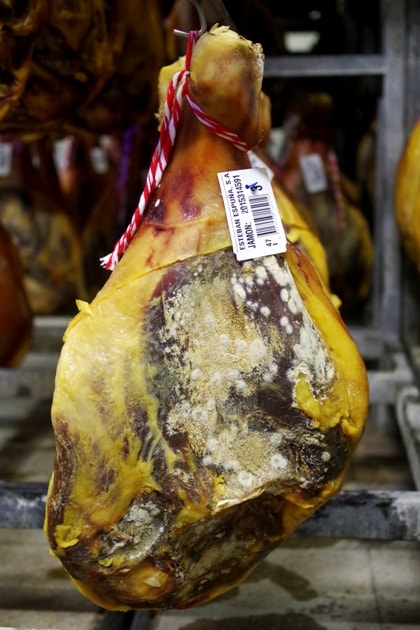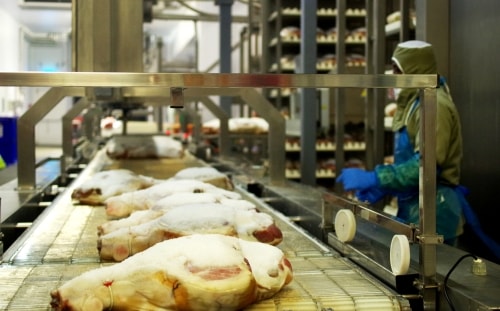A ham leg costs 1,000 euros in Spain
From normal pork leg, after 1-2 years of salting and preserving in different temperature conditions, the Spanish create one of the world's most delicious dishes, each of which can cost up to more than 1,000 euros.
The Spanish call ham ham jamón - a highly valued and carefully selected food. Coming to the land of bulls, you will discover different types of jamón, but the most well-known is stilljamonserrano andjamonIberico.
Serrano comes from "sierra", Spanish for mountain range. And the ingredientsjamonThe iberico is a breed of black pig raised on a pasture and fed acorns instead of conventional farming methods. JAmón Iberico is more famous for its distinctive taste from black pork but jamónSerrano is still the most popular and preferred variety today, due to its much larger production.
 |
| The ham was preserved for 47 weeks in a production facility in Girona, Spain. Photo: Huong Chi. |
Salting is an ancient way to preserve meat for longer. This simple process has been practiced for centuries by the Spanish, who have turned it into an art form, where salt, combined with time and the cold of the mountains, transforms fresh pork into one of the world's most delicious dishes.
The initial source of pork can come from the companies that produce their own hams, or from outside farms. However, the origin of the pigs and the process of caring for them are all controlled by humans and recorded as a "medical book". Each pig will have a barcode to look up related information such as breed, weight, type of food...
This helps processing companies find the cause faster when there is a product that does not meet the requirements. It is the meticulousness in the preparation stage of the raw materials for making ham that gives birth to a delicious Spanish dish.
The process of making salted pork legs includes sorting the legs, trimming off the fat, skin, and tendons, then salting them for 1-2 weeks (depending on the weight of the meat) in containers, rinsing them with water, then keeping them so the salt soaks into the meat and dries for about 1-2 months.
 |
| Salted pork leg processing line with many modern machines. Photo: Huong Chi. |
Next, the pork thighs are hung on high shelves and placed in cold rooms from -1 to 12 degrees Celsius for about 6 months. The meat will gradually become finished products as the nutrients, proteins, fats, etc. change. Finally, the pork thighs are transferred to storage rooms with seasonal conditions, causing 40% of the thigh weight to melt away. This final stage can last 1-2 years.
In production facilities that use modern technology and have few workers, the meat content checking, putting on the conveyor belt, salting, cleaning, hanging on shelves or moving to the storage room... are all done by machines. The temperature in these rooms is gradually increased over time to resemble the seasons of the year.
Each leg initially weighs about 13-15 kg, after processing to produce the final product, the weight can be reduced to 7-10 kg. The price of each ham leg depends on the type of meat, from cheap to very expensive, the expensive type can be up to more than 1,000 euros.
 |
| Jamón is often served with bread spread with fresh tomatoes, olive oil and vinegar. Photo: bbcgoodfood. |
The Spanish only buy whole hams on special occasions like Christmas so they can enjoy them throughout the holiday season. This is also the time when the need to eat and gather with family and friends is higher.
The skin and fat on the outside of the ham can be cut off first and the bones removed to make a delicious soup. The lean meat can be sliced thinly to eat directly or combined with many typical dishes of the land of bullfighting. However, the simplest way to enjoy it while preserving the flavor of the meat is to eat it with a slice of crispy toast spread with tomatoes, olive oil and vinegar as a breakfast dish or as an appetizer in meals.
According to VNE
| RELATED NEWS |
|---|
